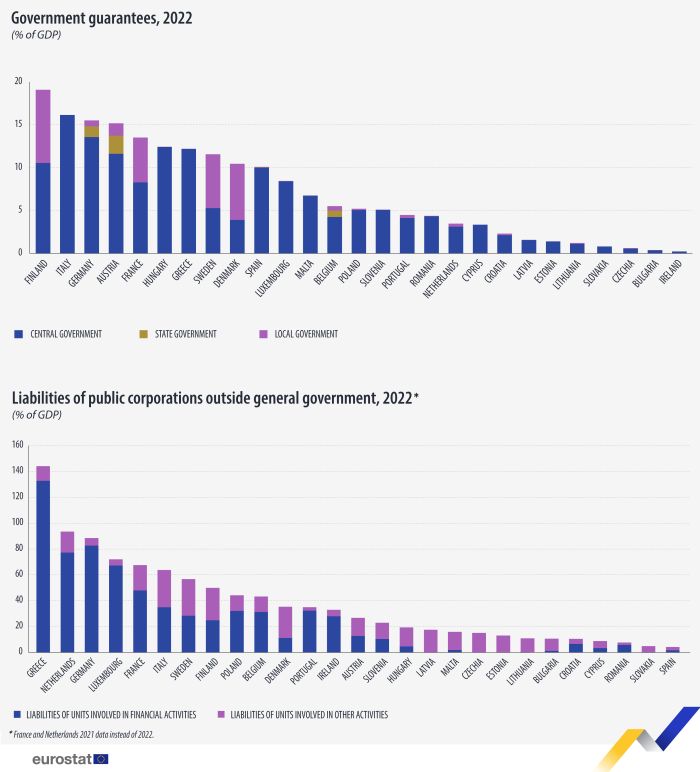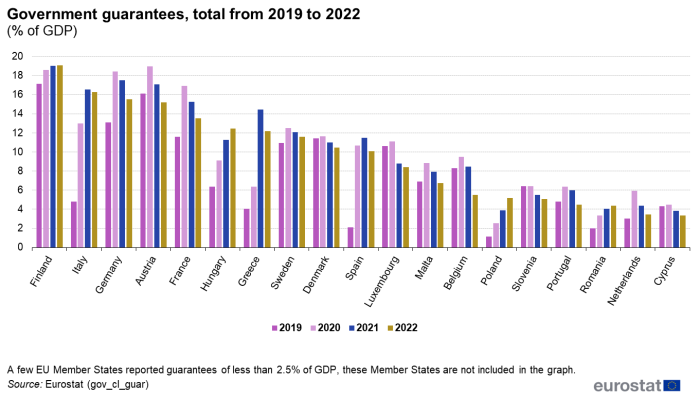Contingent liabilities and non-performing loans - statistics
Data extracted in December 2023
Next planned article update: January 2025
Highlights
The most common form of contingent liabilities (CL) in the EU countries is government guarantees. CL data for 2022 were published today by Eurostat.
In 2022, the highest rates of government guarantees in the EU were recorded in Finland, Italy and Germany.
In 2022, the highest liabilities of public corporations were recorded in the EU countries with sizeable financial institutions under government control.
This article includes data on government guarantees, liabilities of government-controlled entities (public corporations) classified outside general government, and liabilities related to off-balance public-private partnerships (PPPs). Contingent liabilities are only potential liabilities, which may become actual government liabilities if some specific conditions prevail. Similarly, the article also includes data on government non-performing loans (NPLs, assets), which could imply a loss for governments if these loans are not repaid. These data add further transparency to the public finances in the European Union by providing a more comprehensive picture of potential impacts on Member States' financial positions.
Full article
Overview of contingent liabilities
Contingent liabilities data include four main indicators which are typically measured as percent of GDP: (i) government guarantees, the most common type of contingent liabilities; (ii) liabilities of government-controlled entities (public corporations) classified outside general government; (iii) liabilities related to off-balance public-private partnerships (PPPs), whereas off-balance means that these liabilities are not recorded on the government balance sheets; and (iv) government non-performing loans (NPLs, assets). Furthermore, government guarantees could be split into one-off ad-hoc guarantees and standardised guarantees. Standardised guarantees are those guarantees that provide coverage for similar types of credit risk in a large number of typically smaller size contracts. For standardised guarantees, it is usually not possible to estimate precisely the risk of default of each individual guaranteed claim, but it is possible to estimate how many, out of a large number of such loans are likely to default. Likewise, the public corporations classified outside of government are split into non-financial and financial public corporations.
These four indicators are independent of each other and may overlap. For example, the debt of a public corporation classified outside of government may be guaranteed by the government. In this case, the same amount will appear under both indicators (i) government guarantees, and (ii) liabilities of public corporations classified outside government.
The table below presents summary contingent liabilities data reported to Eurostat:
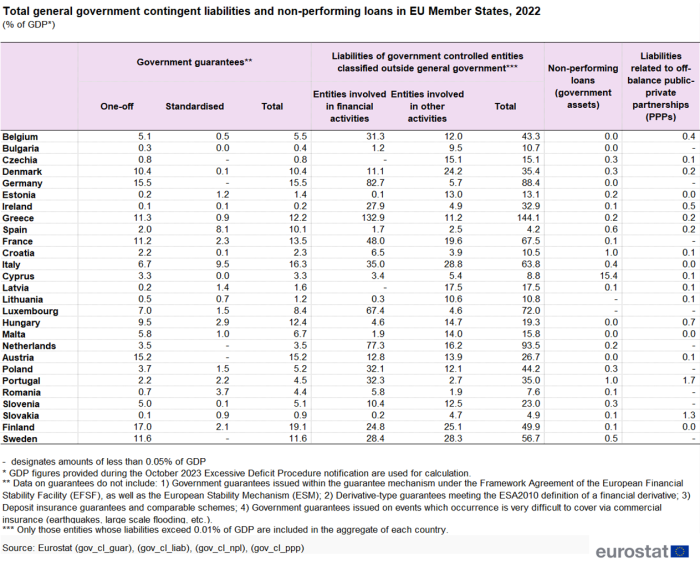
Source: Eurostat (gov_cl_guar), (gov_cl_ppp), (gov_cl_liab), (gov_cl_npl)
The highest rates of government guarantees in the EU were recorded in Finland, Italy and Germany
The most common form of contingent liabilities in the EU countries is government guarantees on the liabilities, and occasionally, on the assets of third parties. In 2020 and 2021, government guarantees provided in the EU increased notably following the onset of the COVID-19 pandemic, as seen in the graph below. In 2022, the level of government guarantees was further influenced by the ensuing energy crisis, following the Russian aggression against Ukraine. In 2022, the highest overall rate of government guarantees was recorded in Finland (19.1 % of GDP), Italy (16.3 %), Germany (15.5 %), Austria (15.2 %) and France (13.5 %). On the lower end of the scale, rates of less than 1 % of GDP were recorded in Slovakia, Ireland, Bulgaria and Czechia.
In most EU countries, the central government is the predominant guarantor. A notable level of local government guarantees can be seen in Finland, Denmark, Sweden and France. In several countries, a major part of the guarantees is provided to financial institutions – notably in Finland, Greece, France, Luxembourg, Belgium and Hungary - often granted in the context of either the COVID-19 crisis or the 2008-09 financial crisis. A significant amount of the guarantees provided during the COVID-19 crisis were in the form of standardised guarantee programmes, i.e., a large number of similar and relatively small ticket-size guarantees, such for example as guarantees for loans to small and medium-sized enterprises.
Further explanations can be found in the country-specific notes on guarantees section below.
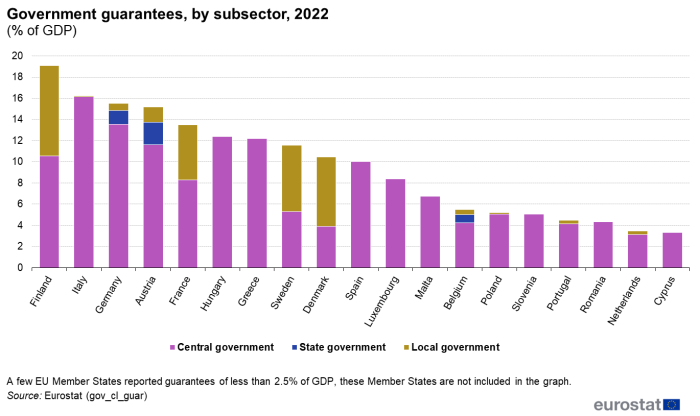
Source: Eurostat (gov_cl_guar)
Liabilities of public corporations the highest in Greece
In 2022, liabilities of public corporations were highest in Greece. The level of liabilities of public corporations classified outside general government varied widely among the EU Member States. Significant amounts of liabilities were recorded in Greece (144.1 % of GDP), ahead of the Netherlands (93.5 %), Germany (88.4 %), Luxembourg (72.0 %) and France (67.5 %). By contrast, small amounts of public corporation liabilities were recorded in Spain (4.2 %), Slovakia (4.9 %); Romania (7.6 %), Cyprus (8.8 %) and Croatia (10.5 %). The main reason for the high level of liabilities in certain Member States is that the data include liabilities of public banks controlled by government. Most of these liabilities consist of deposits held by households or by other private or public entities. In general, financial institutions have much higher amounts of debt liabilities compared with the non-financial corporations. At the same time, these institutions have also significant amount of financial assets, which are not captured in this data collection.
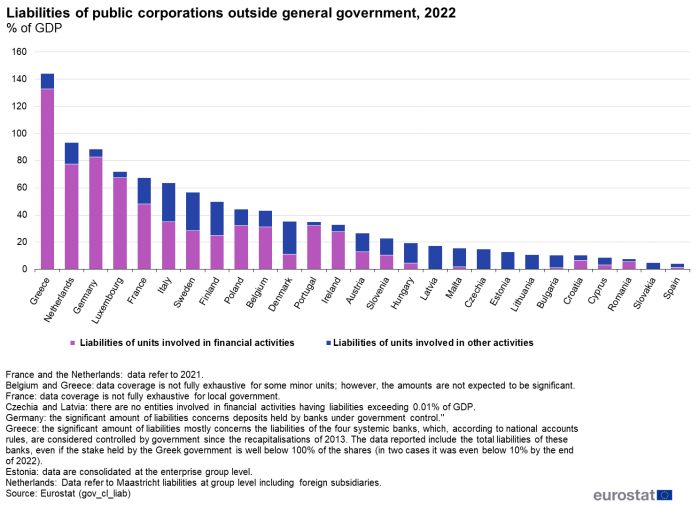
Source: Eurostat (gov_cl_liab)
Cyprus remained the country with the highest level of non-performing loans
In 2022, Cyprus remained the country with the highest stock of non-performing loans (assets) of the general government, at 15.4 % of GDP, followed by Croatia and Portugal, both reporting a share of 1 %. In almost half of the EU Member States, non-performing loans decreased in 2022, as compared with 2021. The highest decrease was observed in Cyprus and Slovenia. This was largely due to loan repayments and migration of loans from NPLs to performing loan status. Recently, Eurostat recommended the 'unlikely-to-pay' (UTP) loans to be considered within the ESA 2010 7.101(c) definition of NPLs and reported accordingly. Implementation of this recommendation by EU Member States is still ongoing. A few Member States are also reporting accounting provisions instead of NPLs at a nominal value, or at a 'reset' value, in case government transfers have been booked against NPL assets. Progress will continue towards harmonization of NPL reporting among EU Member States.
In 2022, liabilities related to off-balance public-private partnerships (PPPs), long-term construction contracts where assets are recorded outside government accounts, were below 2 % of GDP in all EU countries. Nine EU countries had no such liabilities. Portugal had the highest share (1.7 % of GDP), followed by Slovakia (1.3 %) and Hungary (0.7 %). These PPP liabilities are predominantly due to motorway projects. In many EU countries, off-balance PPPs were observed at the central government as well as at the local government level. In addition, a few federal countries, like Belgium, Spain and Austria, also had off-balance PPPs related to state governments.
Source data for tables and graphs
Data sources
Implementation guidance is provided in the Eurostat decision of 22 July 2013 on Supplement on contingent liabilities and potential obligations to the EDP related questionnaire. Annex 1 to the Decision contains two questionnaire forms, the supplement to the EDP related questionnaire on contingent liabilities and potential obligations and the questionnaire on government controlled units classified outside general government. The questionnaires need to be filled by EU Member States' statistical authorities and transmitted to Eurostat annually before 31 December (T+12 months), whereas this publication is being made one month after Member State data are transmitted to Eurostat (i.e., T+13 months). The metadata clarifying the completeness, definitions, use of estimations or timeliness of the data are to be provided to Eurostat alongside the above questionnaire forms.
Main data indicators:
Guarantees are arrangements whereby the guarantor undertakes to a lender that if a borrower defaults, the guarantor will make good the loss the lender would otherwise suffer. A one-off guarantee is defined as individual, and guarantors are not able to make a reliable estimate of the risk of calls. One-off guarantees are linked to debt instruments (e.g., loans, bonds). Data refer to the total stock of debt guaranteed by government units. Standardised guarantees are guarantees that are issued in large numbers, usually for relatively smaller amounts, along identical lines. It is not possible to estimate precisely the risk of each loan being in default but it is possible to estimate how many, out of a large number of such loans, will default. Examples are mortgage loan guarantees, student loan guarantees, etc. Data refer to the total stock of assets covered by the standardised guarantees. While the provisions for standardised guarantees are considered an actual liability, the total stock of assets covered by standardised guarantee is regarded as a contingent liability.
Country-specific notes on guarantees
Italy: Intensive use of the government guarantees as a COVID-19 measure to support the economy led to a notable increase in 2020 and 2021.
France: data coverage has improved since last year, however data for local government is not exhaustive.
Hungary: recent increases were due to increased guarantees on liabilities of public corporations, the inclusion of two guarantee programmes that were previously missing, as well as the COVID-19 pandemic.
Finland, Germany and Sweden: reported guarantee data may not be fully consolidated, leading to potential overestimation (guarantees provided to units already inside general government).
Liabilities of government-controlled entities (public corporations) classified outside general government are defined as the stock of liabilities at the end of the year, based on the business accounts of corporations and reported either as business liabilities or as Maastricht liabilities by the Member States. These government-controlled entities are classified outside general government due to their behaviour as market units. For a better picture of the extent of liabilities depending on the sector activities, these liabilities are split into liabilities of entities involved in financial activities and entities involved in other activities. Entities involved in financial activities include units classified according to NACE Rev 2 Division 64: "Financial service activities, except insurance and pension funding", but excluding sub-division 6411 "National Bank"; Division 65: "Insurance, reinsurance and pension funding, except compulsory social security"; and Division 66: "Activities auxiliary to financial services and insurance activities". Entities involved in other activities refer to units performing all other activities.
Country-specific notes on public corporations
France and the Netherlands: data refer to 2021.
Belgium and Greece: data coverage is not fully exhaustive for some minor units; however, the amounts are not expected to be significant.
France: data coverage is not fully exhaustive for local government.
Czechia and Latvia: there are no entities involved in financial activities having liabilities exceeding 0.01 % of GDP.
Germany: the significant amount of liabilities concerns deposits held by banks under government control.
Greece: the significant amount of liabilities mostly concerns the liabilities of the four systemic banks, which, according to national accounts rules, are considered controlled by government since the recapitalizations of 2013. The data reported include the total liabilities of these banks, even if the stake held by the Greek government is well below 100 % of the shares (in two cases it was even below 10 % by the end of 2022).
Estonia: data are consolidated at the enterprise group level.
Netherlands: Data refer to Maastricht liabilities at group level including foreign subsidiaries.
Non-performing loans (NPLs, government assets): a loan is non-performing when payments of interest or principal are past due by 90 days or more, or interest payments equal to 90 days or more have been capitalised, refinanced, or delayed by agreement, or payments are less than 90 days overdue, but there are other good reasons (such as a debtor filing for bankruptcy) to doubt that payments will be made in full. NPL data are not exhaustive for some Member States. Further methodological guidance is being implemented in order to ensure that NPL definitions, used by different EU Member States, are aligned with the definitions of ESA 2010 (paragraph 7.101).
Public-private partnerships (PPPs) are long-term contracts between two units, one of which is normally a corporation (or a group of corporations, private or public) called the operator or partner, and the other normally a government unit called the grantor. PPPs involve a significant capital expenditure to create or renovate fixed assets by the corporation, which then operates and manages the assets to produce and deliver services either to the government unit or to the general public on behalf of the government unit. Public-private partnership recorded off-balance sheet of government means that the assets are not considered as economically owned by government and the gross-fixed capital formation is not recorded as an expenditure of government at the moment it is incurred. Total outstanding liabilities related to PPPs recorded off-balance sheet of government are expressed as the adjusted capital value. This is an initial contractual capital value that is progressively reduced over time by the amount of "economic depreciation" which is calculated on the basis of estimates or actual data. The adjusted capital value reflects the current value of the asset at the time of reporting. The amount is deemed to reflect the gross fixed capital formation and debt impact in the case that government would have to take over the assets during the life of the contract.
It is to be underlined that the above indicators have a heterogeneous nature and represent different types of potential impact on public finance. Additionally, in some cases, the same fiscal risk might be reflected by two or more indicators. For instance, when a government guarantees the liability of a government-controlled entity classified outside general government, the potential risks are covered both by data presented for 'Guarantees' and 'Liabilities of government-controlled entities classified outside general government'. Therefore, evaluating the total risk for public finance by summing up the indicators could overestimate the potential impact.
Data availability and data quality
Regarding the data availability and data quality, three aspects should be taken into account: data coverage, data completeness and data comparability.
Data coverage and consolidation
The data coverage depends on the respective indicator:
Data for government guarantees relate only to the guarantees provided by government to the units classified outside general government. Data for government guarantees are consolidated, except for two Member States (Finland and Sweden), where there might be double-counting of some guarantees. Data on guarantees do not include: 1) Government guarantees issued within the guarantee mechanism under the Framework Agreement of the European Financial Stability Facility (EFSF) and the European Stability Mechanism (ESM); 2) Derivative-type guarantees meeting the ESA2010 definition of a financial derivative; 3) Deposit insurance guarantees and comparable schemes; 4) Government guarantees issued on events which occurrence is very difficult to cover via commercial insurance (earthquakes, large scale flooding, etc.).
Data for non-performing loans refer to the non-performing loans provided by units included into general government (including all the institutional units which are part of the central, state and local government and social security funds) towards other units which are classified outside general government. Data for non-performing loans are consolidated for the general government. Data provided for particular sub-sectors of the general government might be not consolidated.
For off-balance sheet PPPs data refer to the Private-Public Partnerships projects which are not included in the government accounts. The consolidation is not applicable for this indicator. Off-balance sheet PPPs data do not include data on off-balance sheet concession contracts, as defined in Chapter 2 of the Guide to the Statistical Treatment of PPPs.
For liabilities of public corporations, data covers public corporations classified in the sectors of non-financial corporations (S.11), financial corporations (S.12), non-profit institutions serving households (S.15) and the rest of world (S.2) but which are controlled by the general government sector and with liabilities exceeding 0.01 % of GDP. The data refer only to public corporations classified outside general government. The liabilities of public corporations classified inside general government are fully reflected in the government accounts.
It should be noted that the data reported for liabilities of public corporations classified outside general government is not consolidated at group level, which means that part of the debt of these units could be towards entities in the same company group, which could imply that some liabilities are reported twice. However, the debt between units in the same group is not identifiable from the data reported due to the fact that, as agreed with the Member States in the framework of the 2012 Task Force, the data should be provided to Eurostat for each individual unit and not for accounts at the level of the consolidated group. In the context of the first publication of data on liabilities of government-controlled entities in February 2015, some concerns were raised regarding a possible overestimation of the liabilities due to non-consolidation. Therefore, Eurostat launched a pilot project in order to investigate the availability of consolidated data between public parent companies and their subsidiaries (intragroup consolidation) in individual Member States. Eurostat invited Member States to provide to Eurostat, on a voluntary basis, consolidated group accounts in order to assess the impact of consolidation on the figures published. Several countries are providing intragroup consolidated figures, in addition to the non-consolidated data. These consolidated data can be extracted from the same database using the dimension "gov_cl_liab" CO_NCO (Consolidated-non-consolidated). The analyses of the two sets of data (consolidated versus unconsolidated) corresponding to the same reference year show that for some of the countries there is no substantial impact due to non-consolidation while for some other countries there is a clear overestimation of the liabilities at non-consolidated level.
Data completeness
A lot of progress was achieved in the last years with regard to data completeness. The data is mostly exhaustive for all the indicators and all the Member States. For the Member States for which data is not fully exhaustive, e.g. data for local government is not available or some small units are not included, detailed information is included in the country specific footnotes which are available on Eurostat's website. The country specific footnotes provide information on the exhaustiveness of all four indicators.
Data comparability
Data are country specific and closely linked to the economic, financial and legal structure of the country. In some countries, governments provide more guarantees to units outside general government, while in others, this is not the case. In some Member States there are Private-Public Partnerships projects which are not included in the government accounts, while in some other countries such PPP projects do not exist at all.
With regard to the liabilities of public corporations, it should be mentioned that the data collection only refers to liabilities without balancing them with the assets. This aspect is very important in the case of financial institutions, which normally have both significant amounts of assets and debt liabilities. Some Member States have more entities controlled by general government and involved in financial services than others, and therefore they report higher liabilities than those where such entities do not exist at all, or are few. Additionally, for some of the Member States, a large part of the liabilities reported by financial institutions concern deposits held by households or other public or private entities in government-controlled banks.
With regard to the comparability of data for liabilities of public corporations, it should be also mentioned that, when compiling the liabilities of public corporations, the Member States could choose which concept to use for the reporting of liabilities, either business accounts or national accounts concepts. When reporting the data following the business accounts definitions, the countries included all the liabilities from the financial statements of the company, including also liabilities related to the item other accounts payable (F.8). A majority of countries reported the data for public corporations following the business accounts definitions. Nevertheless, a few countries (e.g., Spain, Belgium, the Netherlands and Slovakia), reported Maastricht liabilities, notably data on liabilities for items (as defined in ESA 2010): currency and deposits (AF.2), debt securities (AF.3), and loans (AF.4) and excluding the item other accounts payables (AF8). Due to the above-mentioned reporting, some additional comparability limits should be also taken into account.
Revision and timetable
Revised data for past years are available in the Eurostat database, along with explanatory information on revisions and/or major changes.
Context
The data on contingent liabilities and potential obligations of government are collected in the framework of the Enhanced Economic Governance package (the "six-pack") adopted in 2011. The economic governance package describes a set of European legislative measures meant to reform the Stability and Growth Pact and to introduce greater macroeconomic surveillance in the European Member States, in response to the European debt crisis of 2009.
In this context, the Council Directive 2011/85 requires the Member States to publish relevant information on contingent liabilities with could have potentially large impacts on public budgets.
The data collection on contingent liabilities represents a step towards more transparency of public finances in the EU by giving a more comprehensive picture of EU Member States' financial positions. In this sense, the data on contingent liabilities includes data on the following indicators: government guarantees, liabilities related to public-private partnerships recorded off-balance sheet of government, liabilities of units controlled by government but classified outside general government (public corporations) and non-performing loans (government assets).
It is to be underlined that contingent liabilities are not part of the general government (Maastricht) debt as defined in the Council Regulation (EC) No 479/2009 of 25 May 2009 on the application of the Protocol on the excessive deficit procedure annexed to the Treaty establishing the European Community.
Nevertheless, the collection of data on the indicators such as government guarantees, liabilities related to public-private partnerships recorded off-balance sheet of government, liabilities of government-controlled entities classified outside general government (public corporations) and non-performing loans (government assets) gives the possibility to capture the so-called government “contingent” liabilities. Contingent liabilities are only potential liabilities and not actual liabilities of government. They can nevertheless materialise and become actual government liabilities only if certain specific conditions prevail. For example, non-performing loans show a bigger risk of non-repayment as normal loans. A significant amount of non-performing loans of government could imply a higher government exposure and a potential loss for government if these loans were not repaid by their original debtor.
The collection and publication of data on the above-mentioned indicators was agreed with the EU Member States in the framework of the Task Force on the implications of the Directive on the collection and dissemination of fiscal data. In addition, the Eurostat Decision of 22 July 2013 on the "Supplement on contingent liabilities and potential obligations to the EDP related questionnaire" provides further details on this data collection and the indicators.
Direct access to
Database
- Government contingent liabilities and potential obligations (gov_cl)
- Government guarantees (gov_cl_guar)
- Liabilities related to private-public partnerships (PPPs) recorded off-balance sheet of government (gov_cl_ppp)
- Liabilities of government-controlled entities classified outside general government (gov_cl_liab)
- Non-performing loans of government (gov_cl_npl)
Dedicated section
Publications
- News Item - Data on contingent liabilities and non-performing loans in the EU Member States (January 2023)
- The Commission Report on implicit liabilities with potential impact on public budgets (February 2019)
- Publication of data related to the Articles 3(2) and 14(3) of the Directive 2011/85 at national level
Methodology
Legislation
- Council Directive 2011/85 of 8 November 2011 on requirements for budgetary frameworks of the Member States.
- Supplement on contingent liabilities and potential obligations to the EDP related questionnaire (July 2013)
